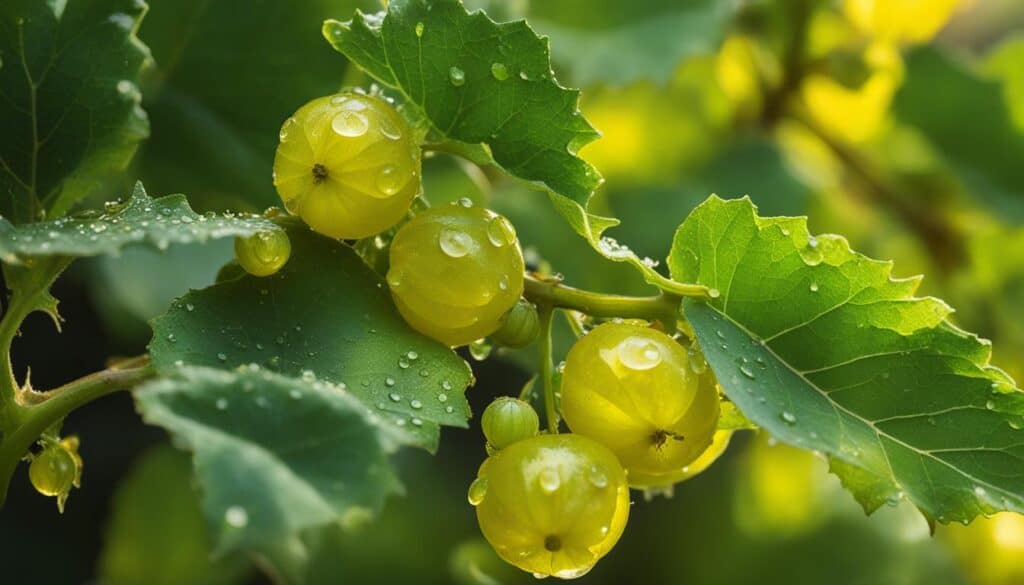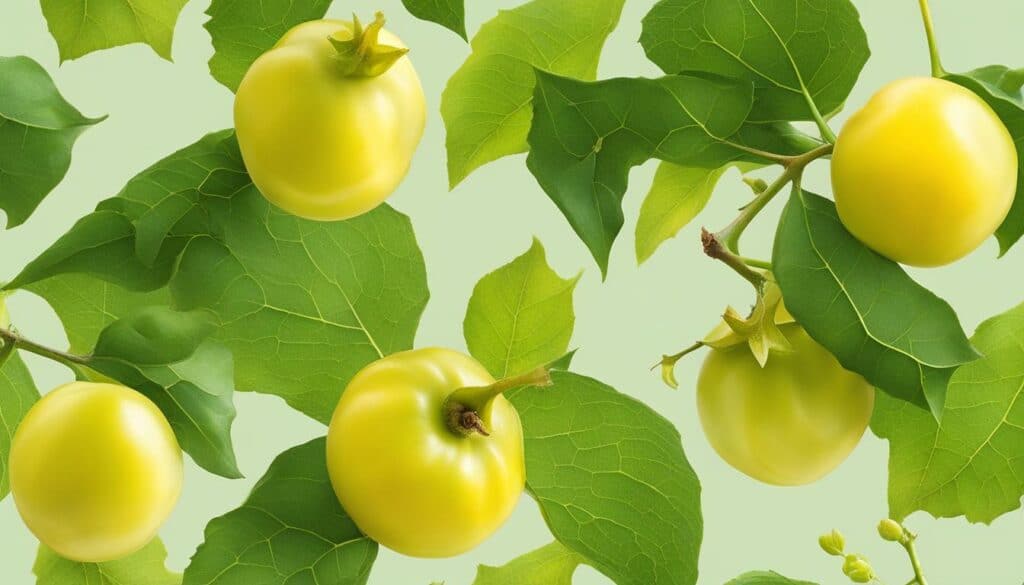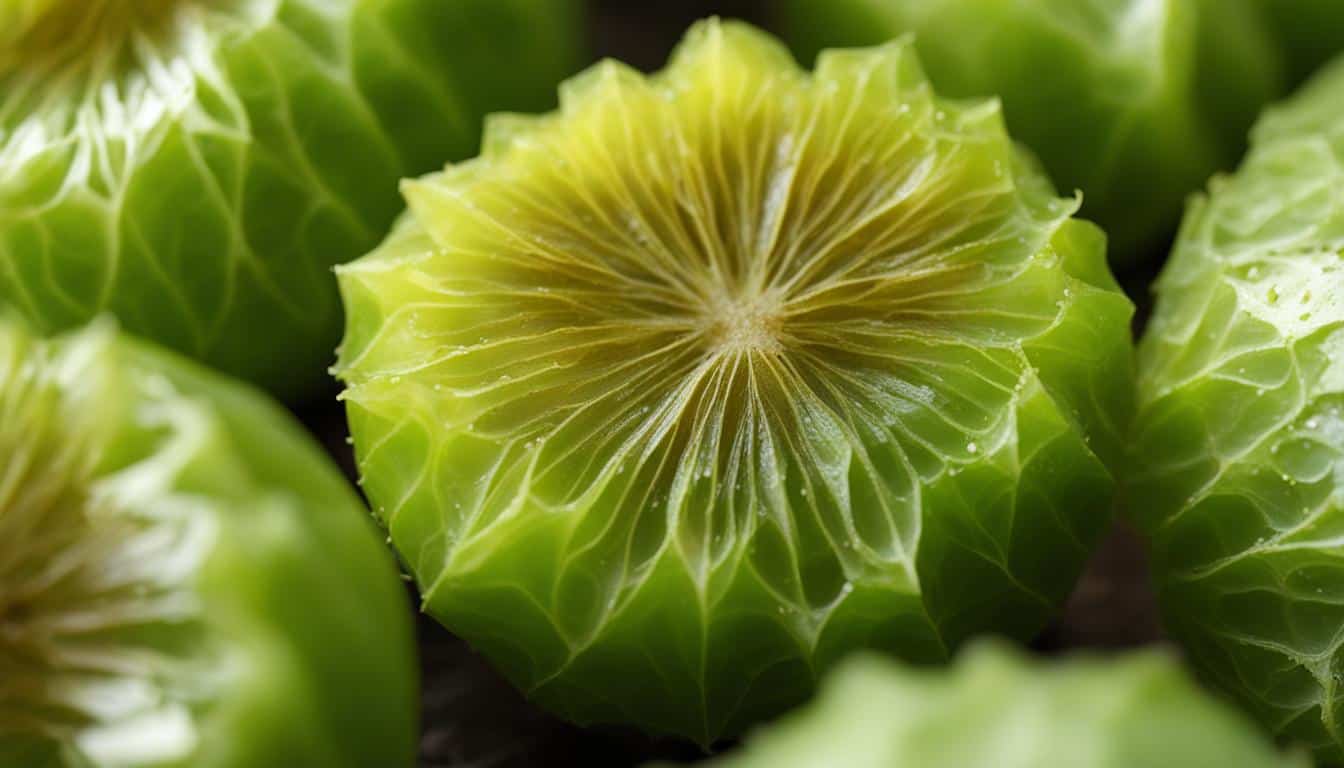Star gooseberry, a tropical fruit with a unique taste, is a delightful addition to any culinary adventure. With its sour, tart, astringent, and subtly sweet flavor, star gooseberry offers a refreshing and tangy experience for your taste buds. This small fruit, with its distinctive star-like appearance, is not only a treat for the palate but also holds cultural significance in certain communities.
As you embark on a botanical journey with star gooseberry, you’ll discover its versatility in the kitchen. From chutneys and preserves to refreshing drinks, this tropical fruit adds a tangy and flavorful element to a variety of dishes. But it’s not just about taste; star gooseberry also offers potential health benefits. Packed with vitamin C, antioxidants, and nutrients, it supports digestion, boosts immunity, and contributes to overall well-being.
So, why not embrace the fusion of flavor and wellness by exploring star gooseberry? Cultivate this tropical treasure, indulge in its unique taste, and unlock a world of culinary possibilities. Your taste buds and your body will thank you!
Key Takeaways:
- Star gooseberry is a tropical fruit known for its unique taste.
- It combines sourness, tartness, astringency, and subtle sweetness.
- Star gooseberry has culinary versatility and can be used in chutneys, preserves, and beverages.
- It is rich in vitamin C, antioxidants, and nutrients that support digestion and boost immunity.
- Cultivating and exploring star gooseberry allows for a connection with nature, flavor, and potential wellness benefits.
Description and Taste of Star Gooseberry
Star gooseberries are small fruits, measuring 1 to 3 centimeters in diameter. They have an oblate to globose shape with shallow, curved ribs. The skin is thin, ripening from pale green to golden yellow, and has a slightly sunken top. The flesh is pale-yellow, firm, crisp, and somewhat translucent. It has a crunchy, succulent consistency. The taste of star gooseberries is sour, tart, astringent, and subtly sweet, creating a unique flavor profile.
These fruits are characterized by their distinctive appearance and size. The oblate to globose shape, along with the shallow, curved ribs, gives star gooseberries their star-like appearance. The thin and smooth skin transitions from a pale green color to a vibrant golden yellow as the fruit ripens. The flesh is pale-yellow and has a firm yet crisp texture, making each bite a delightful experience.
When it comes to taste, star gooseberries deliver a flavor profile that is truly one-of-a-kind. The initial sensation is sour, followed by a tartness that tantalizes the taste buds. The astringent notes offer a refreshing crispness, while the subtle sweetness rounds out the overall taste. This combination of flavors creates a unique and enjoyable culinary experience.
Key Characteristics of Star Gooseberry
| Size | 1 to 3 centimeters in diameter |
|---|---|
| Shape | Oblate to globose with shallow, curved ribs |
| Skin | Thin, ripening from pale green to golden yellow |
| Flesh | Pale-yellow, firm, crisp, somewhat translucent |
| Taste | Sour, tart, astringent, subtly sweet |
Seasons and Availability of Star Gooseberry
Star gooseberries are a tropical fruit that is available year-round in regions with tropical climates. This ensures a consistent supply of star gooseberries for consumption and culinary use throughout the year. However, the peak harvest times may vary in different regions.
In most tropical areas, the harvest season for star gooseberries typically falls between November and January. During this time, the fruits are at their prime, with the perfect balance of sourness, tartness, astringency, and subtle sweetness. Farmers and fruit enthusiasts eagerly await this season to enjoy the unique flavor and versatility of star gooseberries.
It is important to note that star gooseberries thrive in warm climates and are best suited for regions with temperatures above 50°F (10°C). They require ample sunlight and well-draining soil to grow and produce high-quality fruits. In areas with mild winters, star gooseberries can be grown year-round, allowing for a continuous supply of these tangy delights.
Cultivating Star Gooseberries in Different Regions
While star gooseberries are native to tropical regions, they can be cultivated in subtropical areas as well. In regions with colder winters, star gooseberries can be grown in containers and moved indoors during the colder months to protect them from frost. This way, even those in cooler climates can experience and enjoy the unique taste of star gooseberries.
When cultivating star gooseberries, it is essential to choose the right variety that is suitable for the specific climate and growing conditions. Some varieties are more cold-tolerant, while others thrive in hotter climates. Consulting local gardening resources or experts can help in selecting the best star gooseberry variety for your specific region.
Whether you live in a tropical paradise or are experimenting with cultivation in a subtropical climate, star gooseberries offer a delightful and tangy flavor that can be enjoyed all year long. So why not embrace the seasons and availability of star gooseberry and indulge in their tropical allure?
| Region | Peak Harvest Times |
|---|---|
| Tropical Asia | November to January |
| Caribbean | December to February |
| Central America | January to March |
| South America | December to February |
Health Benefits of Star Gooseberry

Star gooseberries are not only a delicious fruit but also a nutritious one. Packed with essential vitamins and antioxidants, they offer a range of health benefits that contribute to overall well-being.
Vitamin C is abundant in star gooseberries, making them a great natural source of this essential nutrient. Vitamin C plays a crucial role in boosting the immune system, protecting against common illnesses, and promoting collagen production for healthy skin and tissues.
The antioxidants found in star gooseberries help fight against harmful free radicals in the body, reducing inflammation and oxidative stress. This can have a positive impact on overall health and may contribute to a lower risk of chronic diseases.
Furthermore, the high fiber content of star gooseberries promotes good digestive health. Fiber aids in digestion, prevents constipation, and supports a healthy gut microbiome. It can also aid in weight loss by promoting feelings of fullness and reducing calorie intake.
| Health Benefits of Star Gooseberry | Summary |
|---|---|
| Rich in Vitamin C | Boosts immune system and promotes collagen production |
| Abundant in Antioxidants | Fights against free radicals, reduces inflammation |
| Promotes Digestive Health | Aids digestion, prevents constipation, supports a healthy gut microbiome |
| Assists in Weight Loss | Promotes feelings of fullness, reduces calorie intake |
In addition to these benefits, star gooseberries have been used in traditional medicine as a natural remedy for various ailments. They have soothing properties that can help alleviate sore throats and relieve coughs. The fruit is also known to aid in calming the stomach and promoting digestive comfort.
With their unique taste and impressive array of health benefits, star gooseberries are a valuable addition to a balanced and nutritious diet.
“Star gooseberries are not only a treat for the taste buds but also a boon for our health. Their vitamin C content helps bolster our immune system, while antioxidants fight off harmful free radicals. Add to that their high fiber content, aiding in digestion and weight loss, and it’s clear that star gooseberries are a fruit worth incorporating into our daily lives.” – Nutritionist Amy Johnson.
Culinary Uses of Star Gooseberry
Star gooseberries are not only known for their unique taste but also for their culinary versatility. These small fruits can be enjoyed in various ways, adding a tangy and flavorful element to a wide range of dishes and beverages. Here are some popular culinary uses of star gooseberry:
Chutneys:
Star gooseberries are often used to create tangy chutneys that complement savory dishes. The tartness of the fruit adds a refreshing twist to the condiment, enhancing the overall flavor of the meal.
Preserves:
Star gooseberries are also commonly used to make delicious preserves, jams, and jellies. The slightly sour taste of the fruit balances well with the sweetness of the preserves, resulting in a delightful treat that can be enjoyed on toast or paired with cheese.
Refreshing Drinks:
Another popular use of star gooseberries is in the creation of refreshing drinks. The tanginess of the fruit makes it a great addition to juices, smoothies, and syrups, offering a burst of flavor that quenches the thirst on hot summer days.
Whether you’re looking to add a unique twist to your meals, create homemade preserves, or enjoy a refreshing beverage, star gooseberries can elevate the culinary experience with their distinctive taste. Get creative in the kitchen and explore the diverse possibilities that this tropical fruit has to offer.
The Cultural Significance of Star Gooseberry
Among the Thai Lanna people, star gooseberries hold a deep-rooted cultural significance and are considered a sacred tree. Legend has it that the wood and branches of the star gooseberry tree were used to forge the weapon of Phaya Yama, the Thai god of death. The Thai Lanna people believe that sprinkling liquids using leafy branches from star gooseberry trees repels demons and ghosts from houses, offering protection to residents. Planting the star gooseberry tree is seen as a lucky symbol, believed to bring good fortune to families and earning respect for those who cultivate it within the community.
Furthermore, the Thai Lanna people’s deep reverence for the star gooseberry tree is reflected in their customs and rituals. The tree is often part of important ceremonies and festivals, symbolizing strength, protection, and connection with the spiritual realm. Its presence in these cultural practices highlights the integral role that star gooseberries play in the lives of the Thai Lanna people.
Thai Lanna Communities and Star Gooseberry
Thai Lanna communities have long cherished the star gooseberry for its cultural significance, considering it a vital part of their heritage. The tree’s unique qualities and its enduring presence in Thai Lanna culture make it an intrinsic part of community identity and traditions. The Thai Lanna people’s deep connection to the star gooseberry showcases the harmonious bond between nature and cultural practices that have been passed down through generations.
| Cultural Significance | Description |
|---|---|
| Thai Lanna people | Consider star gooseberries a sacred tree and believe in their protective properties |
| Legend of Phaya Yama | Star gooseberry tree’s wood and branches were used to forge the weapon of Phaya Yama |
| Customs and rituals | Star gooseberry tree plays a significant role in ceremonies and festivals |
| Community identity | Star gooseberry is an integral part of Thai Lanna community heritage and traditions |
“The star gooseberry tree represents strength, protection, and a connection to our ancestors. It is a symbol of our rich cultural heritage, and we hold it in high regard.”
– Elder from a Thai Lanna community
Celebrating the Richness of Thai Lanna Culture
The cultural significance of star gooseberries within Thai Lanna communities highlights the importance of preserving and celebrating diverse cultural practices and beliefs. Through these sacred trees, the Thai Lanna people express their deep-rooted connection to nature, spirituality, and ancestral wisdom. Understanding and appreciating the cultural significance of star gooseberries provides a glimpse into the rich tapestry of Thai Lanna culture and its enduring traditions.
Geography and History of Star Gooseberry
Star gooseberries, also known as Ceylon gooseberries or jujube berries, are believed to be native to Madagascar, although their exact origin is unknown. These small, oblate to globose fruits with a distinctive star-like appearance have a rich history of cultivation and consumption in various parts of the world.
Star gooseberries first made their way to Southeast Asia, specifically the Philippines, in prehistoric times. From there, they spread throughout the region, including countries like India, Thailand, and Malaysia. The fruit’s popularity continued to grow, and in the late 18th century, star gooseberries were introduced to the Americas, including the Caribbean, Mexico, Central America, and South America.
Today, star gooseberries are cultivated in tropical and subtropical climates worldwide. Southeast Asia remains a significant producer of this fruit, with countries like Thailand and India leading the way. French Polynesia in the South Pacific and parts of the United States, such as Florida and Hawaii, also cultivate star gooseberries.
The Journey of Star Gooseberry: From Madagascar to Southeast Asia and the Americas
Table: Geographic Spread of Star Gooseberry
| Region | Period | Significance |
|---|---|---|
| Madagascar | Unknown | Possible native origin |
| Southeast Asia | Prehistoric | Introduction of star gooseberry to the region |
| Americas | Late 18th century | Introduction of star gooseberry to the Americas |
| Tropical and subtropical regions worldwide | Present | Current global cultivation |
The geographic spread of star gooseberries showcases their adaptability to different climates and their ability to thrive in diverse environments. As this delightful fruit continues to be appreciated by cultures around the world, its unique taste and culinary versatility continue to captivate enthusiasts and food lovers, making it a beloved and cherished part of regional cuisines.
The journey of star gooseberry from its possible native origin in Madagascar to its widespread cultivation in Southeast Asia and the Americas is a testament to the fruit’s allure and adaptability. Its unique taste, coupled with its ability to grow in various climates, has made it a cherished ingredient in global culinary traditions.

As we delve into the history and geography of star gooseberries, we can appreciate their journey from Madagascar to Southeast Asia and the Americas. This botanical treasure has found a home in different corners of the world, enriching local cuisines and captivating taste buds with its distinctive flavor.
Cultivation of Star Gooseberry
Successfully cultivating star gooseberries requires careful attention to several key factors. From selecting the right location to proper planting, watering, pruning, and fertilization, each step plays a vital role in ensuring healthy growth and abundant fruit production.
Location Selection
When choosing a spot in your garden for star gooseberries, opt for an area that receives full sunlight. This tropical fruit thrives in bright, direct sunlight, which promotes optimal growth and fruit ripening. Additionally, ensure the soil is well-draining to prevent waterlogging, which can lead to root rot.
Planting and Watering
Plant star gooseberry seeds or young plants in the selected location, following the spacing recommendations provided on the seed packet or plant label. After planting, water the seedlings thoroughly to establish their root systems. During the growing season, maintain consistent watering, making sure the soil is moist but not overly saturated. This will help the plants stay hydrated and encourage healthy growth.
Pruning and Fertilization
Regular pruning is essential for maintaining the health and shape of your star gooseberry plants. Remove any dead, damaged, or overcrowded branches to allow for better airflow and light penetration. This will reduce the risk of pests and diseases and promote overall plant vigor. Additionally, fertilize the plants with a slow-release fertilizer formulated for fruit-bearing trees. Follow the manufacturer’s instructions for application rates and timing to provide the necessary nutrients for robust growth and abundant fruit production.
| Aspect | Details |
|---|---|
| Location | Sunny spot in the garden with well-draining soil |
| Planting | Follow spacing recommendations on seed packet or plant label |
| Watering | Maintain consistent watering, keeping soil moist but not saturated |
| Pruning | Remove dead, damaged, and overcrowded branches |
| Fertilization | Apply slow-release fertilizer according to manufacturer’s instructions |

Culinary Tips:
- Create a refreshing star gooseberry juice by blending the fruits with water, lime juice, and a touch of honey or sugar. Serve chilled for a revitalizing beverage.
- Add star gooseberry to your favorite salad for a tangy twist. Its unique flavor pairs well with greens, nuts, and a light vinaigrette dressing.
- Experiment with star gooseberry in your baking adventures. Add it to muffins, cakes, or pies for a burst of tartness that complements the sweetness of other ingredients.
“Star gooseberry brings a burst of tanginess and a hint of sweetness to my dishes. I love how it adds a unique flavor to both savory and sweet recipes, and I appreciate its potential health benefits as well.” – Chef Jones
| Nutrient | Amount per 100g |
|---|---|
| Vitamin C | 33mg |
| Calories | 35 |
| Fiber | 4g |
| Antioxidants | High |
Embracing a Botanical Journey with Star Gooseberry
Embarking on a botanical journey with star gooseberry allows for a deep connection with nature’s treasures and the exploration of taste and health. Cultivating these unique fruits from seed to plate is a gratifying experience that showcases the beauty and resilience of the natural world.
Through careful cultivation, star gooseberry plants transform from tiny seeds into vibrant trees, offering a bountiful harvest of tangy and refreshing fruits. The process of selecting a sunny spot in the garden, planting the seeds or young plants, and providing consistent care nurtures the growth of these remarkable trees. Witnessing their development and knowing that they will become a source of culinary delight and potential wellness benefits adds a sense of fulfillment to the journey.
Delving into culinary explorations with star gooseberries unveils a world of possibilities. These versatile fruits can be enjoyed raw, sprinkled with salt or sugar for a burst of flavor. They also lend themselves to a variety of cooked preparations, including tangy chutneys, flavorful preserves, and refreshing beverages. The unique taste of star gooseberries adds an exciting dimension to a wide range of dishes, elevating their flavor profiles and captivating the palate.
The botanical journey with star gooseberry is not just about taste; it is also about embracing the potential health benefits that these fruits offer. Rich in vitamin C, antioxidants, and other nutrients, star gooseberries contribute to overall well-being. From boosting the immune system to aiding digestion and promoting weight loss, these natural treasures have the power to enhance our sense of vitality and wellness.

| Benefits of Embracing a Botanical Journey with Star Gooseberry | |
|---|---|
| Taste Exploration | Discover the tangy allure and unique flavor of star gooseberry in a variety of culinary creations. |
| Connection with Nature | Nurture star gooseberry plants and witness the transformative journey from seed to a source of culinary delight. |
| Potential Wellness Benefits | Unlock the health-promoting properties of star gooseberries, including immune-boosting vitamin C and antioxidants. |
Conclusion
As you embark on a culinary adventure, don’t miss out on the unique taste and incredible versatility of star gooseberries. These small fruits pack a flavor punch, combining sourness, tartness, astringency, and subtle sweetness into a delightful taste experience. Whether you enjoy them raw, in chutneys and preserves, or in refreshing beverages, star gooseberries add a tangy and flavorful element to your dishes.
But star gooseberries offer more than just a fantastic taste. They also come with a range of health benefits. Packed with vitamin C and antioxidants, star gooseberries boost your immune system, promote digestion, and contribute to overall wellness. They have been used for centuries as natural remedies, soothing sore throats, relieving coughs, and calming upset stomachs.
Moreover, star gooseberries hold cultural significance in certain communities, such as the Thai Lanna people. Seen as a sacred tree, the star gooseberry carries a rich history and symbolizes good fortune and respect. By cultivating and exploring the culinary possibilities of star gooseberries, you can connect with nature, flavor, and the potential wellness benefits they offer. So, embark on this botanical journey and discover the tangy allure and unique flavor of star gooseberry in your own culinary creations.
FAQ
What does a star gooseberry look like?
Star gooseberries are small, oblate to globose fruits with a distinctive star-like appearance. They have a thin, taut, and smooth skin that ripens from pale green to golden yellow.
What is the taste of a star gooseberry?
Star gooseberries have a sour, tart, astringent, and subtly sweet taste, providing a unique and refreshing flavor experience.
When are star gooseberries available?
Star gooseberries are available year-round in tropical climates, with peak harvest times usually occurring between November and January.
What are the health benefits of star gooseberry?
Star gooseberries are a nutritious fruit that offers several health benefits. They are a good source of vitamin C, contain antioxidants, aid in digestion, cleanse the digestive tract, purify the blood, contribute to weight loss, and can be used in natural remedies for soothing sore throats, relieving coughs, and calming the stomach.
How can star gooseberries be used in cooking?
Star gooseberries can be eaten raw, sprinkled with salt or sugar. They can also be used to create tangy chutneys, jams, jellies, preserves, and refreshing drinks like juices and syrups.
What is the cultural significance of star gooseberry?
Among the Thai Lanna people, star gooseberries are considered sacred and are believed to repel demons and ghosts when sprinkled in houses. The tree is also seen as a lucky symbol, bringing good fortune to families and earning respect for those who plant it in the community.
Where do star gooseberries come from?
Star gooseberries are believed to be native to Madagascar but were introduced to the Philippines in prehistoric times. They spread throughout Southeast Asia, the Indian Ocean islands, and the South Pacific. In the late 18th century, they were transported to the Americas, including the Caribbean, Mexico, Central America, and South America.
How do you cultivate star gooseberries?
To successfully cultivate star gooseberries, choose a sunny spot in the garden with well-draining soil. Plant the seeds or young plants in the desired location, provide consistent watering, organic mulch, pruning, and slow-release fertilizers during the growing season.
What is the fusion of flavor and wellness in star gooseberry?
Star gooseberry offers a harmonious blend of tanginess and sweetness, making it a refreshing and enjoyable culinary experience. It also carries potential health benefits, being rich in vitamin C, antioxidants, and nutrients that support digestion, boost immunity, and contribute to overall well-being.
How does star gooseberry connect with taste and health?
Cultivating and incorporating star gooseberries into culinary explorations allows for a connection with nature, flavor, and potential wellness benefits. Experience the tangy allure and unique flavor of star gooseberry in your culinary adventures.





Leave a Reply